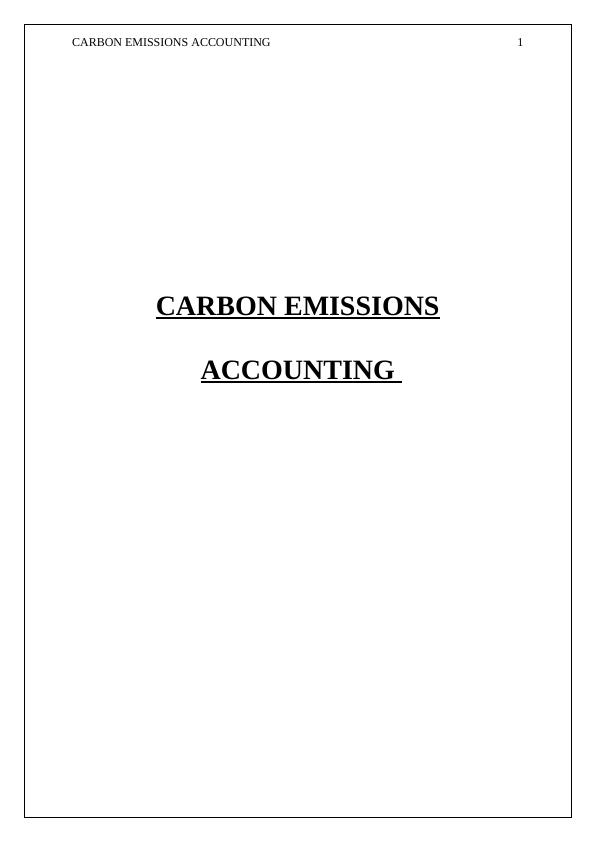Ask a question from expert
Nature of Emission Allowances
12 Pages2663 Words128 Views
Added on 2020-02-24
Nature of Emission Allowances
Added on 2020-02-24
BookmarkShareRelated Documents
CARBON EMISSIONS ACCOUNTING1CARBON EMISSIONSACCOUNTING

CARBON EMISSIONS ACCOUNTING2Nature of emission allowances:Mainly the legal nature of the allowances for the emissions have been issued and also aretraded under the rules of the European emission Trading Scheme (EU ETS). This is thoughhas not been harmonised at the level of the EU.The definition of the term allowances has been done under the Article 3(a) of the ETSDirective wherein it has been prescribed that only one tonne of carbon dioxide shall beemitted during any period. This would be valid in order to meet the requirements that havebeen laid done under the ETS Directive. This would also be transferrable as per theprovisions of the ETC Directive. The notification issued in this regard reports on thefunctioning of the carbon market of Europe. This accompanies the report on thedocumentation which forms the part of the council. There has been a climate action progressreport that includes the functioning of the carbon market f Europe and also the report whichlays down its view of the Directive 2009/31/EC. This has been done on the geological storageof the carbon dioxide as on the date of November 18, 2015. This describes the emissionallowances as the following:Financial instrumentsIntangible assetsProperty rightsState propertyCommodities (Emissions, 2017).Accounting nature:As per the IASB rules, wherein the accounting standards fail to apply on the company, thenthe disclosure has to be made as per the IAS 8 Accounting Policies, Changes in accounting

CARBON EMISSIONS ACCOUNTING3Estimates and Errors. This requires in the fact that the management must use their judgmentwhen it comes to the development and the application of the policy of accounting whichresult in the information which is relevant and also reliable. This has to be done inconsultation with the auditors of the firm. The following are the accounting standards as perwhich the accounting would take place:International Accounting Standard (IAS) 2 Inventories; IAS 20 Accounting for Government Grants and Disclosure of GovernmentAssistance;IAS 37 Provisions, Contingent Liabilities and Contingent Assets; IAS 38 Intangible Assets; and IAS 39 Financial Instruments: Recognition and Measurement. The carbon emissions are taken into account in accounts as per the Commodities, fortrading purposes etc.Measurement:Under the system, the producers of the electric power were given or also they had acquired inthe credits with regard to the free credits which covers up the SO2 and also the NOxemissions but there is as such no accounting standard under the US GAAP which wouldthrow some light on the financial accounting for the programs of emissions. The FASB hasjoined hands with the International Accounting standards Board or the IASB that wouldaddress in the scheme of the carbon emissions for the purposes of accounting. There are somemore regulations that relates with the emissions that have been produced by the largestsources of the nation. The EPA has been making it compulsory for the companies to reportthe GHG levels (Hindu business line, 2017). There are many of the companies that wouldaccount for the cap and trade activities which are connected with the program when there are

CARBON EMISSIONS ACCOUNTING4as such no specific authoritative guidance on the procedure. There are many of the companiesthat are duty bound to report the impact of the change in the climate and the regulations of theGHG emissions in their financial statements on Form 10 K. it is of an utmost importance thatthe companies have the management strategy for carbon since those activities would helpthem in complying and accounting for these stated activities but also the company will beallowed to take the advantage of all of the credits and offset the same through the way ofstrategic acquisition (ACCA global, 2017).Current accounting practices:There are many of the companies that have been operating in the United States and thesecompanies mostly belongs to the power and the utilities industry. These have been acquiredfor the purposes of participating in the EPA, RGGI and other such programs related with suchcarbon emissions and these have been associated since a long number of years. There aremany of the programs that have a cap and trade model as well. Since there is an absence of aset standard in the US GAAP or in the (IFRS) which takes into account the emission credits,renewable energy, emission offsets or such similar allowances, hence different practices arebeing followed in this respect. Hence, there is an urgent need of providing a framework forthe purposes of accounting for the climatic changes, the one that could be applied to all of theindustries without any issue. The FASB and the IASB have joined in hands so as to work forthe emissions trading schemes since the year 2007 (PBR, 2017).Current accounting for emissions credits or allowances:

End of preview
Want to access all the pages? Upload your documents or become a member.
Related Documents
Advanced Accounting Issues Assignment 2022lg...
|16
|4231
|16
Financial Information Analysis about Carbon Emission Disclosureslg...
|10
|2126
|4
PACC 6005 Financial Accounting Assignmentlg...
|10
|2481
|62
FINANCIAL ACCOUNTING FINANCIAL ACCOUNTING 2 Financial Accountinglg...
|7
|1611
|125
IFRS 9, Impairment of Non-Financial Assets, Income Taxes - Notes to Financialslg...
|9
|1768
|66
The Regulatory Environment and Financial Reportinglg...
|7
|848
|75